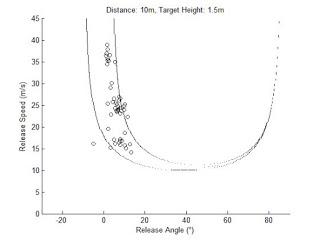There are many new analysis techniques within this 'motor abundance' framework, and I've reviewed most of them already; uncontrolled manifold analysis, stochastic optimal control theory and goal equivalent manifolds are the three big ones, as well as nonlinear covariation analysis. The essence of all these methods is that they take variability in the execution or outcome of a movement, and decompose that variability into variability that does not interfere with achieving the outcome and variability that does.
This post will explain the variability decomposition process in Sternad & Cohen's (2009) Tolerance, Noise and Covariation (TNC) analysis, which my students and I are busily applying to some new throwing data from the lab. I have talked a little about this analysis here but I focused on the part of the analysis that involves a task dynamical analysis identical to the one I did for my throwing paper in 2016. In this post, I want to explain the TNC analysis itself. I will be relying on Sternad et al, 2010, which I've found to be a crystal clear explanation of the entire approach; you can also download Matlab code implementing the analysis from her website.
Motivation
Sternad et al (2010) explain that the key motivation for developing this analysis is to remove worrying researcher degrees of freedom. UCM and the related analyses decompose variance in the kinematics of the performance of an action. There are many ways to express these kinematics; in terms of joint positions, velocities, or angles (relative or absolute). UCM gives you different answers depending on the coordinate system of the kinematic data, which makes coordinate frame a researcher degree of freedom that is rarely justified a priori. Sternad solves this by a) moving the analysis to results in execution space and b) defining that execution space a priori by a task dynamical analysis. While I think that there may be room to use UCM's coordinate sensitivity as a way to explore data for evidence of which frame of reference is behaviourally relevant, I am 100% on board with Sternad's analysis of the problem, as well as her solution. The only thing I will do here that goes beyond what she does is say that in order for the task dynamics to constrain action variability, they must be perceived. This makes behaviourally relevant task dynamics affordances (Wilson et al, 2016) and also means that the story isn't complete until we have the information analysis as well. But this task dynamical analysis is the right place to start.Task Dynamics of Throwing
I have reviewed this specific analysis in detail here. The key is that throwing entails creating a projectile motion that either maximises distance or intercepts a distant target. For a given projectile, the dynamics of projectile motion requires three initial conditions to be specified; release angle (relative to the ground plane), release velocity (speed and direction), and release height (relative to the target height). The task dynamical analysis therefore specifies a priori that this is the execution space in which the results must be analysed. (Both Dagmar and I restricted our analysis to the 2D release angle/release speed space, because that's where most of the control action is. I did see some tentative evidence that release angle was being adaptively controlled in the 2016 paper, however, so I do want to extend this back out to the 3D execution space. I will focus here on the 2D analysis because it's way easier to graph :)Within that space of possible release parameter combinations, there is a subset that achieve the goal. For example, for a target that has some non-0 size, you can miss the center but still hit the target. This subset is referred to as the result function (bounded by lines of constant result) which maps parameter combinations onto results, and the subset of the result function that produces 0 error (e.g., exactly hits the center of the target) is the solution manifold. (Sternad notes that this function can be readily identified, but so far I've only been able to map it point by point in the simulations, rather than identify the actual function.)Figure 1 plots an example of of result functions from 2016 with one of Dagmar's; her throwing task is actually a tetherball task, so her dynamical analysis, while still projectile motion, produces a different result function to my untethered throwing task. The underlying analysis is identical, however.Figure 1. Result functions for two throwing tasks, plotted in execution space. Left, Wilson; Right, Sternad
All of the following analysis evaluates the data you record from your participants relative to this solution manifold and result function. As you can see, not all regions of the space are equally useful; sometimes the result function is very narrow. But this result function gives you a reference frame to evaluate various aspects of the variability in the observed distribution of data;- Does it lives in the most stable region of the space (Tolerance)
- How much noise it shows (Noise)
- Does it shows evidence of a synergy in action between the execution space variables (Covariation).
Figure 2. Observed release angle/release speed combinations with the result function for that condition



